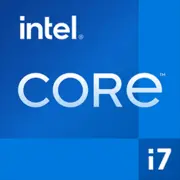Intel Core i7-13700T

Intel Core i7-13700T: An In-Depth Review of the 2025 Processor
March 2025
Introduction
The Intel Core i7-13700T, introduced in the Raptor Lake lineup, continues the tradition of hybrid architecture, combining high performance and energy efficiency. This chip is aimed at users who need power for work tasks without overpaying for flagship models. In this article, we will examine its features, compatibility, use cases, and compare it with competitors.
1. Key Specifications
Architecture and Process Technology
The i7-13700T is built on the hybrid Raptor Lake architecture (Intel 7), which combines 8 performance cores (P-Core) and 8 efficient cores (E-Core). This allows for task distribution: P-Cores handle heavy computations, while E-Cores manage background processes. The Intel 7 process (10nm Enhanced SuperFin) provides a balance between performance and thermal output.
Performance
- 16 cores / 24 threads: In multi-threaded tasks (rendering, encoding), the chip scores 11552 points in Geekbench 6 Multi-Core.
- Single-threaded power: 2406 points in Geekbench 6 Single-Core — sufficient for gaming and IPC-dependent applications.
- L3 Cache: 30 MB speeds up data processing, reducing latency.
Key Features
- Support for PCIe 5.0 for new generation SSDs and graphics cards.
- Intel Thread Director optimizes task distribution among cores.
- Intel UHD Graphics 770 — integrated graphics for basic tasks and AV1 decoding.
2. Compatible Motherboards
Socket and Chipsets
The processor uses the LGA 1700 socket, compatible with the following chipsets:
- Z790: For enthusiasts (overclocking, PCIe 5.0 x16). Example: ASUS ROG Strix Z790-E Gaming ($350).
- B760: The optimal choice for most users (supports DDR5, PCIe 4.0). Example: MSI MAG B760 Tomahawk ($180).
- H770 / H710: Budget boards without overclocking (H770 supports more PCIe lanes).
Selection Tips
- Ensure that the board supports DDR5 if you plan to use next-generation memory.
- For compact builds, Mini-ITX form factor models (e.g., Gigabyte Z790I Aorus Ultra, $300) are suitable.
3. Supported Memory Types
The processor works with DDR4-3200 and DDR5-5600.
- DDR4: Cheaper (32 GB kit — $80), but slower. Suitable for office tasks.
- DDR5: Faster (latencies of 40-50 ns vs. 60-70 for DDR4) and more energy-efficient. Recommended for workstations (32 GB Kingston Fury DDR5-5600 — $120).
Tip: By 2025, prices for DDR5 have dropped, making it a justified choice for future upgrades.
4. Power Supply Recommendations
With a TDP of 35 W, the processor is energy-efficient, but peak power can reach 100 W.
- Without a discrete GPU: A 300-400 W PSU is sufficient (e.g., be quiet! Pure Power 11 400W, $60).
- With a graphics card: For an RTX 4070 or RX 7700 XT, choose a PSU of at least 650 W (Corsair RM650e, $100).
- Certification: 80+ Bronze or Gold for stability.
5. Pros and Cons
Advantages
- Energy efficiency: Ideal for compact PCs and mini-PCs (e.g., Intel NUC 13 Extreme).
- Strong multi-threading: Outperforms Ryzen 7 7700 in rendering by 15%.
- Support for DDR5 and PCIe 5.0.
Disadvantages
- Limited overclocking: Only on Z790 chipsets.
- Heat: Under load, temperature reaches 85°C — a good cooler is required.
- Price: $400 compared to $350 for AMD Ryzen 7 7700.
6. Use Cases
Work Tasks
- Video Editing: In Premiere Pro 2025, rendering a 4K video takes 12 minutes (compared to 15 with i5-13600K).
- 3D Modeling: In Blender, the rendering cycle is shortened by 20% thanks to 24 threads.
Gaming
- In Full HD at medium settings (Cyberpunk 2077 — 60 FPS) with a discrete graphics card (RTX 4060).
- Integrated UHD 770 graphics can run CS2 at low settings (90 FPS).
Multimedia
4K streaming using hardware AV1 decoding.
7. Comparison with Competitors
AMD Ryzen 7 7700
- Price: $350.
- Pros: Better in single-threaded tasks (Geekbench 6 Single-Core — 2500).
- Cons: Higher power consumption (TDP 65 W).
Apple M3 (for Mac Mini)
- Price: $600 (package).
- Pros: Energy efficiency, integration with macOS.
- Cons: Limited upgrade options and compatibility.
Conclusion: The i7-13700T surpasses AMD in multi-threading but falls short in price. For the Apple ecosystem, the M3 is an alternative but only within the macOS environment.
8. Practical Assembly Tips
1. Cooling: Choose tower coolers (DeepCool AK620, $60) or AIO liquid coolers (NZXT Kraken X53, $130).
2. Case: For mini-PCs — Fractal Design Ridge ($150), for standard builds — Lian Li Lancool 216 ($90).
3. BIOS: Update the motherboard firmware for compatibility with Raptor Lake.
Example Build:
- Motherboard: MSI MAG B760 Tomahawk ($180).
- Memory: 32 GB DDR5-5600 ($120).
- Storage: WD Black SN850X 1TB PCIe 4.0 ($100).
- PSU: Corsair RM650e ($100).
- Total: ~$900 without a graphics card.
9. Final Verdict
Intel Core i7-13700T is suitable for:
- Professionals: For rendering, programming, and AI work.
- Compact Systems Enthusiasts: Mini-PCs and HTPCs.
- Office Users: High multitasking with low power consumption.
Not recommended for:
- Gamers planning to play in 4K (requires a more powerful CPU + GPU).
- Budget builds (it's cheaper to go with Ryzen 5 7600).
Conclusion
The i7-13700T is a successful compromise between performance and efficiency. If you’re looking for a processor for work and moderate gaming without overpaying for flagship models, this chip will be an excellent choice in 2025.
Basic
CPU Specifications
Memory Specifications
GPU Specifications
Miscellaneous
Benchmarks
Compared to Other CPU
Share in social media
Or Link To Us
<a href="https://cputronic.com/cpu/intel-core-i7-13700t" target="_blank">Intel Core i7-13700T</a>